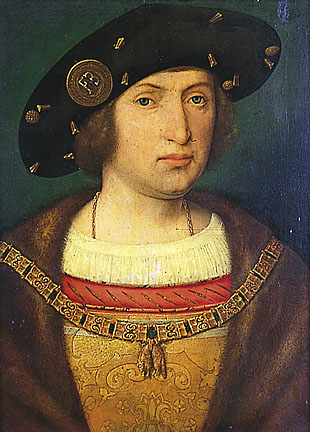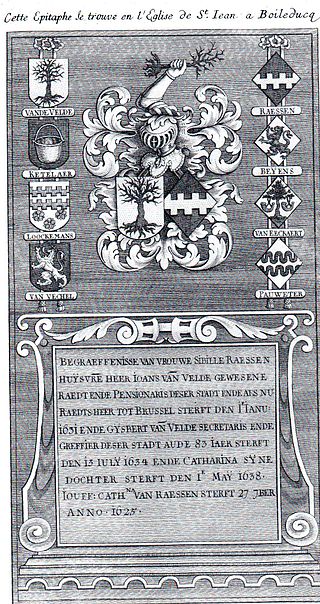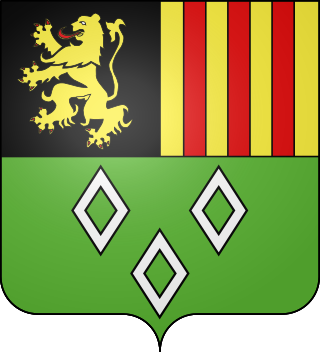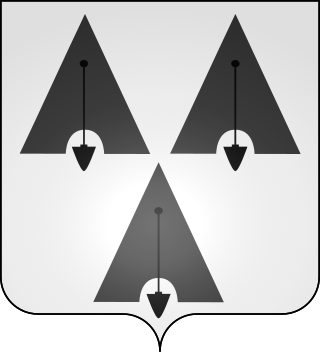
The House of Rohan is a Breton family of viscounts, later dukes and princes in the French nobility, coming from the locality of Rohan in Brittany. Their line descends from the viscounts of Porhoët and is said to trace back to the legendary Conan Meriadoc. Through the Porhoët family, the Rohans are related to the Dukes of Brittany, with whom the family intermingled again after its inception. During the Middle Ages, it was one of the most powerful families in the Duchy of Brittany. The Rohans developed ties with the French and English royal houses as well, and they played an important role in French and European history.
Eustace I Granier, also known as Eustace Grenier or Eustace Garnier, called in Latin Eustachius Granarius in the charters, was a Flemish crusader who took part in the First Crusade. He became lord of Caesarea in 1101 and lord of Sidon in 1110. On 18 April 1123, he was elected constable and bailiff of Jerusalem during the captivity of Baldwin II of Jerusalem. Shortly before his death, he defeated a Fatimid army at the Battle of Yibneh near Ibelin.
Eustace Grenier is quoted in a text in verse written during his life in honour of the knights of the diocese of Thérouanne who accompanied Baldwin of Boulogne to the Holy Land.
Contemporary authors and historians identify Eustace Grenier as a nobleman from the diocese of Thérouanne in the County of Saint-Pol. Alan V. Murray, historian of the Crusades, writes: "However, his origins can be established with a high degree of certainty. The Versus de viris illustribus diocesis Tarvanensis qui in sacra fuere expeditione identifies him as a Fleming from the diocese of Therouanne".

The House of Hornes was an old and important European noble family, which became extinct in the male line in 1826. The name refers to Horn, a small village in Limburg, located in the Netherlands.

Floris van Egmond was count of Buren and Leerdam and Lord of IJsselstein and Sint Maartensdijk. He was stadtholder of Guelders (1507–1511) and Friesland (1515–1518)
The Société des Antiquaires de France is a Parisian historical and archaeological society, founded in 1804 under the name of the Académie celtique. It is now based at the Louvre, in the pavillon Mollien.

The Van de Werve family is one of the oldest Belgian noble families from Antwerp that is still in existence.
Jeanne de Béthune, Viscountess of Meaux, Countess of Ligny, was a French noblewoman, the suo jure Viscountess of Meaux, having inherited the title upon her father's death in 1408. Her father was Robert VIII de Béthune, Viscount of Meaux. Jeanne married twice; firstly to Robert of Bar, and secondly John II of Luxembourg, Count of Ligny who held Joan of Arc prisoner following her capture by the Burgundians in May 1430. Jeanne was one of the three women who cared for Joan during her imprisonment.

Jersey, officially the Bailiwick of Jersey, is a British crown dependency.

Beyens de Grambais is a Dutch-Belgian family of nobility, with a branch settling in the Southern Netherlands in the early 17th century.

Vilain and Vilain XIIII is a Belgian noble family. Their coat of arms is basically "Sable, on a chief argent a label of the field", a colour scheme that is present from the earliest Vilains in the 15th century, and is also seen in the Vilain XIIII arms, which have the "XIIII" added to it.

The de Lalaingfamily is a noble family from the south of Flanders which played an important role in the history of the County of Hainaut and of the Netherlands. The current family belongs to the Belgian nobility.

The House of Lannoy is the name of an old and important Belgian noble family that takes its name from the town of Lannoy in northern France. The name comes from l'Annoy, which means 'the alderwood' in Picard French of Flanders.
Anselme de Peellaert was a nobleman from Bruges.

The House of Glymes was an old Belgian noble family, an illegitimate branch of the House of Reginarid, which ruled the Duchy of Brabant. Glymes or Glimes is a municipality of Incourt. Their descendants of the Grimberghen branch held the title Prince de Grimberghen.

Brimeu is a noble family, some members belonging to the Flemish aristocracy. Brimeux, previously in Flanders, is now in France.
Marquess of Saint-Floris was a French noble title, belonging to the Picardian nobility. Saint-Floris is a town in former Flanders.
Philippe III Alexandre Emmanuel François de Ghistelles died 1808, was a French noble lord. He was 4th Marquess of Saint-Floris, Lord of Beuvry and became the 1st Prince de Ghistelles in 1760.
the Lords of Robecque, (Robecq) belonged to the Feudal Belgian nobility, Robecque is in Artois, now France.

The Wittouck family (/witʊk/) is a noble Belgian family, that descends from the Seven Noble Houses of Brussels, established in Brussels since the 18th century.











